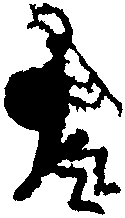Kokopelli
From Wikipedia, the free encyclopedia
Kokopelli is a fertility deity, usually depicted as a humpbacked flute player (often with a huge phallus and feathers or antenna-like protrusions on his head), who has been venerated by some Native American cultures in the Southwestern United States. Like most fertility deities, Kokopelli presides over both childbirth and agriculture. He is also a trickster god and represents the spirit of music.[1]
Among the Hopi, Kokopelli carries unborn children on his back and distributes them to women (for this reason, young girls often fear him). He often takes part in rituals relating to marriage, and Kokopelli himself is sometimes depicted with a consort, a woman called Kokopelmana by the Hohokam and Hopi.[2]
Kokopelli also presides over the reproduction of game animals, and for this reason, he is often depicted with animal companions such as rams and deer. Other common creatures associated with him include sun-bathing animals such as snakes, or water-loving animals like lizards and insects. Because of this, some scholars believe that Kokopelli's flute is actually a blowgun (or started out as one). Alternatively, the "flute" may actually be a pipe for smoking tobacco in a sacred ceremony, or some other device entirely.
In his domain over agriculture, Kokopelli's fluteplaying chases away the Winter and brings about Spring. Many tribes, such as the Zuni, also associate Kokopelli with the rains.[3] He frequently appears with Paiyatamu, another flautist, in depictions of maize-grinding ceremonies. Some tribes say he carries seeds and babies on his back.[3][4]
In recent years, the emasculated version of Kokopelli has been adopted as a broader symbol of the Southwestern United States as a whole. His image adorns countless items such as T-shirts, ball caps, and keychains.[5] A bicycle trail between Grand Junction, Colorado, and Moab, Utah, is now known as the Kokopelli Trail.
Contents |
[edit] Origins and development

Kokopelli has been worshipped since at least the time of the Ancient Pueblo Peoples.[1] The first known images of him appear on Hohokam pottery dated to sometime between AD 750 and AD 850.[1]
Kokopelli may have originally been a representation of ancient Aztec traders, known as pochtecas, who traveled to this region from northern Mesoamerica. These traders brought their goods in sacks slung across their backs and this sack may have evolved into Kokopelli's familiar hump (in fact, many tribes make Kokopelli a trader in this way.[1] These men also used flutes to announce themselves as friendly as they approached a settlement.[1] This origin is still in doubt, however, since the first known images of Kokopelli predate the major era of Aztec-Anasazi trade by several hundred years.[1]
Another theory is that Kokopelli is actually an anthropomorphic insect. Many of the earliest depictions of Kokopelli make him very insect-like in appearance. The name "Kokopelli" may be a combination of "Koko", another Hopi and Zuni deity, and "pelli",[3] the Hopi and Zuni word for the desert robber fly, an insect with a prominent proboscis and a rounded back, which is also noted for its zealous sexual proclivities. A more recent etymology is that Kokopelli means literally "kachina hump". Because the Hopi were the tribe from whom the Spanish explorers first learned of the god,[1] their name is the one most commonly used.
Kokopelli is one of the most easily recognized figures found in the petroglyphs and pictographs of the Southwest.[4] The earliest known petroglyph of the figure dates to about A.D. 1000.[4] Kokopelli was one of several kachina dolls sold to tourists. The Spanish missionaries in the area convinced the Hopi craftsmen to omit the phallus from their representations of the figure. As with most kachina dolls, the Hopi Kokopelli was often represented by a human dancer. These dancers apparently had great fun with missionaries and tourists by making obscene and sexual gestures that the foreigners did not understand.
A similar humpbacked figure is found in artifacts of the Mississippian culture of the U.S. southeast.[6] Between approximately 1200 to 1400 AD, water vessels were crafted in the shape of a humpbacked woman. These forms may represent a cultural heroine or founding ancestor, and may also reflect concepts related to the life-giving blessings of water and fertility.
[edit] Other names
- Kokopele
- Kokopelli-mana or Kokopelmana (actually, Kokopelli's wife) (Hohokam)
- Kokopeltiyo
- Kokopilau
- Neopkwai'i (Pueblo)
- Ololowishkya (Zuni)
- Minha Pica
[edit] References
- ^ a b c d e f g "Kokopelli - Trickster God". Chrysta Links. http://www.crystalinks.com/kokopelli.html. Retrieved on 2008-05-31.
- ^ Young 18.
- ^ a b c "Kokopelli Legends & Lore". KokOasis. http://web.archive.org/web/20030909195331/http://kokoasis.com/legends.html. Retrieved on 2008-05-31.
- ^ a b c "Kokopelli Legends & Lore". Glenn Welker. http://www.indigenouspeople.net/kokopelli.htm. Retrieved on 2008-05-31.
- ^ Leo W. Banks. Tucson Weekly 1999. "Cuckoo for Kokopelli".
- ^ "MISSISSIPPIAN CULTURES FROM ELSEWHERE". National Park Service (US Interior Dept.). http://www.nps.gov/archive/ocmu/Elsewhere.htm. Retrieved on 2008-05-31.
- Slifer, Dennis, and Duffield, James (1994). Kokopelli: Flute Player Images in Rock Art. Santa Fe, New Mexico: Ancient City Press.
- Young, John V. (1990). Kokopelli: Casanova of the Cliff Dwellers: The Hunchbacked Flute Player. Palmer Lake, Colorado: Filter Press. ISBN 0-86541-026-7.
[edit] Further reading
- Malotki, Ekkehart. Kokopelli: The Making of an Icon. (Univ. of Nebraska Pr., 2000). ISBN 0-8032-3213-6 (hardcover), ISBN 0-8032-8295-8 (paper).
- Martineau, LaVan, The Rocks Begin to Speak, KC Publications, Las Vegas, Nevada, 2003
- Patteson, Alex, A Field Guide to Rock Art Symbols of the Greater Southwest, Johnson Books, Boulder, Colorado, 1992
- Schaafsma, Polly, Rock Art in New Mexico, Museum of New Mexico Press, Santa Fe, New Mexico, 1992
- Slifer, Dennis, The Serpent and the Sacred Fire; Fertility Images in Southwest Rock Art, Museum of New Mexico Press, Santa Fe, New Mexico, 2000
- Slifer, Dennis, Signs of Life: Rock art in the Upper Rio Grande, Ancient City Press, Santa Fe, New Mexico, 1998
- Titiev, Mischa, The Story of Kokopele, American Anthropologist, 41.1 (Jan-Mar, 1939): 91-98
| Wikimedia Commons has media related to: Category:Kokopelli |




